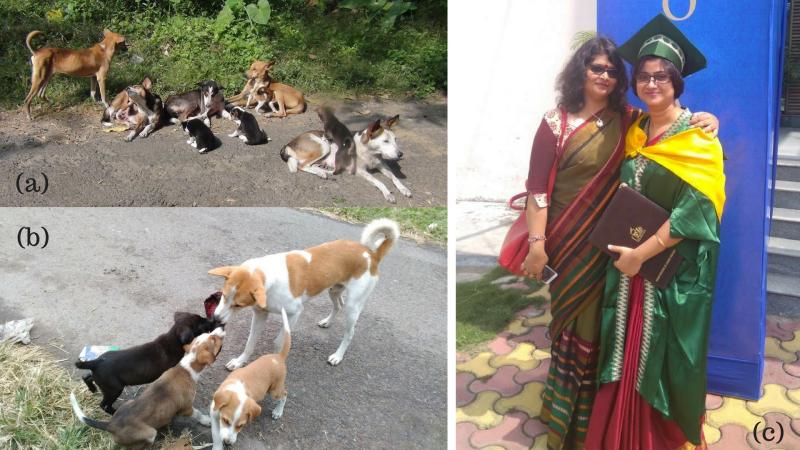
Some curse them, throw stones at them, beat them, and even kill them, while a few pet them and form a special bond! Domestic dogs, or Canis lupus familiaris, are known to be our 'best friends'. Yet, nearly 70-80% of the 90 crore dogs globally, about 70 crores, are free-ranging and include stray and feral dogs. How do they survive and thrive in the dangerous streets without our active care? It turns out, just like us, they have a 'family' that makes it possible.
In a recent study, Prof Anindita Bhadra, from the Indian Institute of Science Education and Research (IISER) Kolkata and her student Dr Manabi Paul, have deciphered the family structures of free-ranging dogs in India by studying the parental care behaviour in them. The results, published in the journal PLoS ONE, may have a lesson or two for humans too!
The study found that the breeding biology and parental care among free-ranging dogs exhibit striking similarities with our joint family system. While we have now mostly moved away from this system where multiple members of the family took care of the younger ones, free-ranging dogs seem to have continued this tradition and are reaping the benefits as well!
“People all over the world seem to believe that dogs are quite ‘happy’ being pets. This study reveals that dogs, in fact, have their own families with complex dynamics that strongly influence the development of pups”, says Prof Bhadra. “So, how early is too early for separating puppies from their siblings and their families? Even dog professionals agree that this study raises some genuine concerns over the way humans breed, rear and train dogs”, she further adds.
The study states that such a breeding strategy, where multiple members of the group take care of the young, might also help their survival in an unpredictable habitat. The researchers believe that this strategy could have helped dogs to adapt to living among humans during the process of domestication that gave us dogs from wolves 35000 years ago.
The researchers continuously observed 15 dog packs, consisting of a total of 84 pups and 50 adults, in the state of West Bengal from 2010 to 2015. However, that wasn’t easy! Although there were a few residents who loved dogs, fed them, welcomed the researchers and told them where pups were, not all shared the same vibe.
“The primary challenge for our study came from humans—they kill dogs, chase them away or steal pups, leading to loss of data. We would begin observations on a group, and one fine day, the pups would be dead, or the mother would have been killed in an accident. Sometimes, people even object to a person sitting and observing dogs in the neighbourhood”, shares Prof. Bhadra.
The study provides support for two hypotheses about the lives of free-ranging dogs. The first one is the ‘benefit-of-philopatry’ hypothesis, where philopatry is the tendency of an animal to return to a particular area. The hypothesis states that dogs tend to return to the place they were born to give birth as their ‘sisters’ or close kin would be around.
The researchers found that the ‘putative father’—caregiving males who may or may not be the biological father—showed comparable levels of care towards the younger ones just like the mothers. While the mothers nursed and groomed the pups, the putative fathers protected and played with them. Other female dogs, related to the mother, also took care of the young ones, though the level of care was comparatively less. The researchers opine that by being close to relatives and helping each other, dogs have an evolutionary advantage.
The second hypothesis, called the ‘assured fitness returns’ hypothesis, is similar to how our insurance policies work. “If I have life insurance and pay a premium, my nominee receives an assured sum when I die. Similarly, by taking care of each other’s pups, the individuals living in groups have an ‘assured fitness return’ of the survival of the offspring”, explains Prof Bhadra. “If a dog is solitary, then its death would mean the death of its offspring. In a group, however, other members take care of the young when an individual dies. Hence, by providing a fraction of the care required, the caregiver gets an assured return of “fitness” in evolutionary terms”, she adds.
Sharing insights about the significance of the study, Prof Bhadra says, “regarding the sampling effort and rigour, this is the first study of this kind on free-ranging dogs. For the first time, we have a detailed understanding of the different forms of care that pups receive, and this has revealed the cooperation-conflict dynamics within the dog groups”.
As part of further studies, the researchers hope to study the father-pup relationship in free-ranging dogs genetically. “All previous work on dogs are on pets, as there are no strays in the West. However, I believe that free-ranging dogs are a much better model to understand domestication”, reveals Prof Bhadra, sharing her motivation to study their territorial behaviour, social dynamics and parental care.
As the intolerance towards the free-ranging dogs is rising around us, the study helps us realise that the dogs have their own lives in the streets which is their natural habitat. The researchers hope that a scientific understanding of the ecology and behaviour of dogs might lead to a society that compassionate and inclusive for dogs too.





